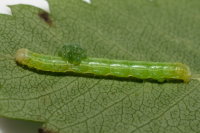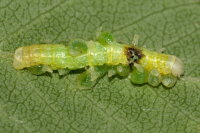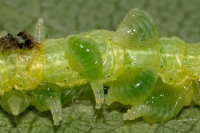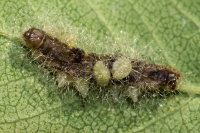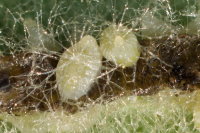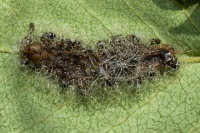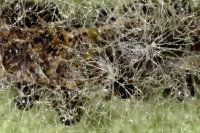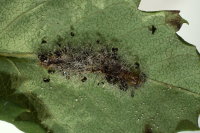3
Spannerraupe mit Ektoparasiten - Hymenoptera: Chalcidoidea: Eulophidae: Euplectrus sp.
Geometer moth caterpillar with ectoparasites - Hymenoptera: Chalcidoidea: Eulophidae: Euplectrus sp.
I found the green caterpillar with larvae of ectoparasites on mountain ash (Sorbus aucuparia). The next day the larvae had increased in size and spread over the whole caterpillar. One day later the dead caterpillar was surrounded by a light-coloured web and had taken on a brown colour. At least some of the threads of the web came from the parasites, which had lost their greenish colouring. After another 4 days only dark formations (pupae?) were visible under the web where the parasites were situated. Remains of these formations can be seen on the last picture.
Unfortunately I have not found any imagines. Maybe they managed to escape because of their small size. Another possibility is that the wasps were killed by an entomophagous fungus.
In the internet you can find pictures of similar looking larvae, which were assigned to chalcid wasps of the genus Euplectrus. The larvae of the genus Euplectrus develop as ectoparasitoids on caterpillars of various species. Before oviposition, the Euplectrus female injects a venom into the host caterpillar to prevent moulting. This makes it impossible for the caterpillar to shed the parasitoids while moulting. The stalked eggs are usually laid on the caterpillar's back and fastened with an anchor at the end of the stalk below the cuticle but above the hypodermis of the host. The larvae feed on the caterpillar's haemolymph. Before pupating, the adult larvae migrate to the underside of their host and spin a loose cocoon around the dying caterpillar, where they pupate. The silk is produced by the larvae using modified Malpighian tubules and secreted through the anal opening.
The ability of Euplectrus larvae to spin a cocoon is unique among the Eulophidae.
References, further reading, links:
- Noyes, J.S. 2019. Universal Chalcidoidea Database. World Wide Web electronic publication. http://www.nhm.ac.uk/chalcidoids
- Christer Hansson, M. Alex Smith, Daniel H. Janzen, and Winnie Hallwachs: Integrative taxonomy of New World Euplectrus Westwood (Hymenoptera, Eulophidae), with focus on 55 new species from Area de Conservación Guanacaste, northwestern Costa Rica. Zookeys. 2015; (485): 1–236. Published online 2015 Mar 10. doi: 10.3897/zookeys.485.9124.

